Abstract
It is well known that the technological performance level of wireless communications in open frequency bands has increased considerably in the last years. Today, many devices that we use is based on wireless communications. This article aims to achieve a practical comparison between 802.11n and 802.11ac performance standards. Practical determinations were made through performance measurements in a wireless communications infrastructure, built by interconnecting pairs of wireless access point equipment, located in close proximity, to ensure maximum performance. The performances of IEEE 802.11ac and 802.11n standards were studied using the traffic measurement method, observing the necessary bandwidth and the response time for different sizes of data packets generated in the testbed communication infrastructure. An important aspect that was taken into consideration refers to the constant monitoring of resources load used for communication processes (CPU load from routers used in test process), to ensure that determinations were not compromised by hardware limitations of the equipment used.
Keywords: 80211n80211acwireless standardsperformance measurementsmonitoring resources
1.Introduction
The IEEE 802.11ac is nowadays the most advanced standard for data transmission over a wireless
environment. This communication standard can be briefly characterized by the following significant features:
providing high-throughput communications, reaching Gbit/s speed level;
proposing the migration to a cleaner 5GHz spectrum;
offering the opportunity for the implementations having mixed frequency bands for data
transmission, in the 2.4 GHz and 5GHz;
supports more performant MIMO (Multi-User Multiple-Input Multiple-Output) mode for
transmission antennas, that can be used to send information simultaneously to multiple clients, up
to four simultaneous MU-MIMO (Multi-User Multiple-Input Multiple-Output) downlink clients;
superior Modulation and Coding Schemes (MCS) with high signal modulations as QAM -
Quadrature amplitude modulation (QAM 256);
space multiplexing thought SDMA (Space Division Multiple Access), up to eight spatial streams
(compared with for in 802.11n MIMO);
commonly, the 802.11ac standard has 10 MCS (Andrew von Nagy, 2013).
Wireless technologies are widely implemented in the most diverse devices (IEEE, 2016). Wireless
chips are currently encountered on tablets, smartphones, TVs, game consoles, printers and the list could
continue. In parallel, to support the equipment growth, multiple wireless networks must be deployed in
various places, which include institutions, schools, shopping malls, universities and others. Wireless
hotspots with Internet access are also commonly installed in public areas, where any user can connect and
access resources it needs (Ong et al., 2011).
Lately, with the passing years, it is found that one of the trends of communications market
development is represented by the IT services migration into the cloud, to ease the use of resources. In the
early era of data communications, the first services were not very specific requirements on parameters, but
in our time, there are some services that require certain parameters to be within certain limits (delay, jitter,
packet loss) to function properly. In this sense, we can exemplify with the streaming video services, which
are very popular today (Park, 2011).
2.Purpose of the Study
The Wi-Fi standards have evolved over time, aiming to surmount the 802.3 Ethernet standard
performances, by providing the necessary resources and support to the current communication services.
(Punal, Escudero, & Gross, 2011; Cha et al., 2012; Bellalta et al.,2012).
This article is proposing a performance appraisal of IEEE 802.11ac, having the previous standard,
802.11n, as a reference (Dianu, Riihijarvi, & Petrova, 2014). Performance measurements regarding traffic
speeds, available bandwidth, volume of date packets sent or lost over data links having various physical
medium characteristics, such as frequency and channel bandwidth are presented in the following sections.
2.1.Research Methodology
To achieve the proposed objectives there was used an operational stand based on two wireless
routers, provided by the company Asus, RT-AC66U series. The technical specifications of this device
state that the maximum global amount of wireless traffic that can be delivered is 1.7Gbit/s. Since there are
wireless connections and technologies, the expected effective throughput is normally beyond this
maximum data transfer value. For example, in any wireless link, it will be traffic control sessions
necessary to maintain the connection flows.
In the proposed experiments one router was used as configured in the AP (Access Point) mode.
And a different firmware than the default was used, to increase the communication capabilities, compared
with those provided by the standard firmware version. On the AP mode router was used a DD-WRT
firmware version because it permits to test communication facilities on both concern frequency bands, 2.4
GHz and the 5 GHz separately. The second router was used in the AP-Client mode, so the WAN port was
not used and the IP allocation facility, the DHCP server was disabled. For the client router, the
configuration was realized with the original firmware, since that it is providing sufficient resources for the
Media Bridge mode interconnection. Two usual laptops with Intel processor i3 / i5 and 4GB / 8GB of
available RAM have been used for generating and receiving the testing data traffic.
2.2.Generic Testbed
The first idea of this practical evaluation is to test the maximum transport capacity of the wireless
testbed system. For obtaining a ground reference, in the initial phase, an Ethernet cable was used between
laptops. The maximum transport capacity obtained was 720Mbit/s.
For a synthetic overview, in Figure
infrastructure used for practical determinations.
To generate packets between the two test laptops there was used the
Dugan, Ferguson, & Gibbs, 2016) a common Linux connections testing application, with five parallel
sessions.
The command used for starting the
#iperf -s -i 1
For the client mode was used in the following form:
#iperf –c server_ip –i 1 –P 5 –t 60
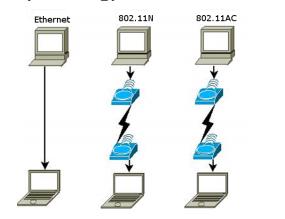
The second idea of the evaluation method is to determine the transport capacity, taking into
consideration the maximum number of packages that can be transported by the wireless link. For this
matter, another Linux utility was used the well-known
source to destination can determine and the packet loss where there are any. Considering that this model
of router has a MIPS processor at a frequency of 600 MHz, a special attention was focused on monitoring
resources (the processor load level), to ensure the no hardware limitations will affect the testing process.
In the following determination, there will be notices about the router’s processor load during the tests.
In conducted experiments, 802.11ac showed better results in terms of data traffic values, as
expected. What is important is to notice the reached performance level and the differences in other
standards. The general results are presented in Table
As it could be observed, in terms of response time and packet loss we can pull some conclusions.
During the tests, there was obtained satisfactory results for the minimum package size (64 bytes). Our
practical determinations were stopped at the 10,000 PPS (packets per second) level, where the response
time parameter was presenting a good value (1-2 ms) and there were no losses.
The next sets of tests were made at the maximum level of package size parameter that can be
enforced with the ping utility (65,508 bytes). The results showed that the 802.11n in 20 MHz band did not
achieve satisfactory results, and were not included in those presented in this paper, as can be identified in
following tables (Tables
3.Results Interpretation
The general results from Table
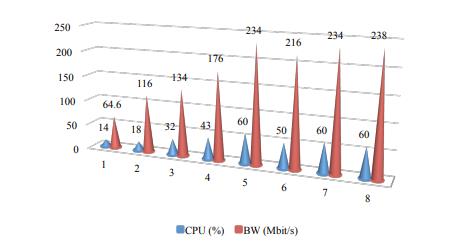
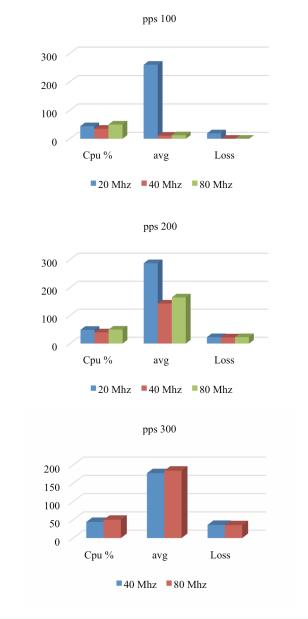
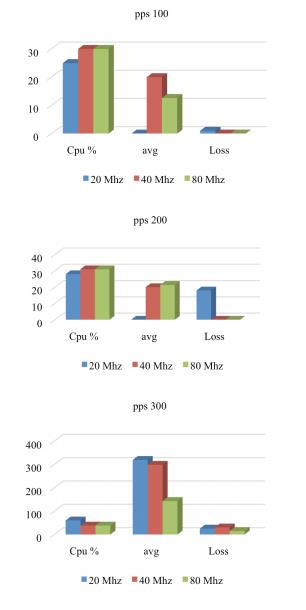
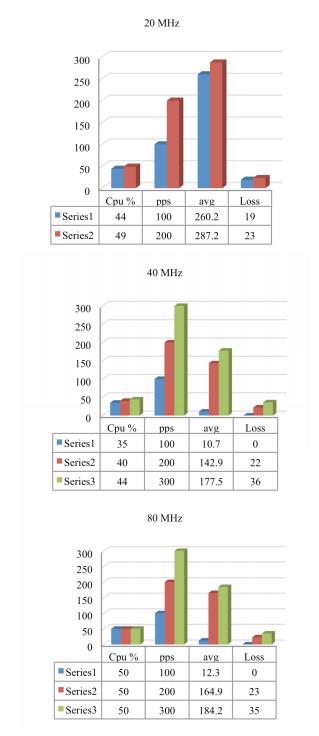
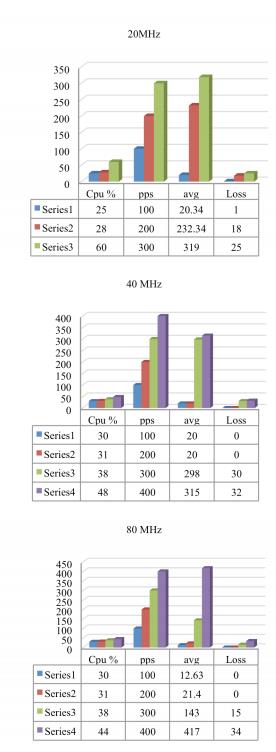
4.Conclusions
In this paper, there are presented the results from an analysis study over the communication
performances provided by the IEEE 802.11ac standard. Although IEEE 802.11ac is an evolved wireless
standard, regarding IEEE 802.11a, as shown by the practical determinations from this paper, there are
considerable performance differences to pull through in the future implementations regarding the Ethernet
standard, which is being still the preferable solution for reliable data communications.
Given the order of the WiFi standards development, it is in the offing that the results to be better
for newer standards. Experiments showed in this article are made under real conditions and have shown
important practical differences between the widely and common used wireless standards, that can be taken
into consideration at the projecting and deployment of new wireless network infrastructures.
The article can be viewed as a basis for future similar comparative measurements when new waves
and generation of wireless standards will be available (802.11ax, 802.11ad, LiFi and others
communication standards that will be developed).
References
- Bellalta, B.; J. Barcelo, D. Staehle, A. Vinel, and M. Oliver, (2012). On the Performance of Packet Aggregation in IEEE 802. 11ac MU-MIMO WLANs. IEEE Communications Letters, vol. 16, no. 10, pp. 1588-1591, October.
- Cha, J.; H. Jin, B. C. Jung, and D. K. Sung, (2012). Performance comparison of downlink user multiplexing schemes in IEEE 802. 11ac: Multi-user MIMO vs. frame aggregation. in Proc. of IEEE WCNC'12. IEEE, pp. 1514-1519.
- Dianu, M. D.; J. Riihijarvi and M. Petrova, (2014). Measurement-based study of the performance of IEEE 802.11ac in an indoor environment, Communications (ICC), 2014 IEEE International Conference on, Sydney, NSW, pp. 5771-5776, doi: 10.1109/ICC.2014.6884242
- Ong, E. H.; J. Kneckt, O. Alanen, Z. Chang, T. Huovinen, and T. Nihtila, (2011). IEEE 802. 11ac. Enhancements for very high throughput WLANs. inProc. of IEEE PIMRC'11. IEEE, pp. 849-853.
- Park, M. (2011). IEEE 802. 11ac: Dynamic bandwidth channel access . inProc. of IEEE ICC'11. IEEE,
- pp. 1-5.
- Punal, O., H. Escudero, and J. Gross, (2011). Performance comparison of loading algorithms for 80 MHz
- IEEE 802. 11 WLANs. in Proc. of IEEE VTC Spring'11. IEEE, pp. 1-5.
- Tirumala, A.; F. Qin, J. Dugan, J. Ferguson, and K. Gibbs (2016), Iperf: The TCP/UDP bandwidth
- measurement tool. Current version available online at http://code. google. com/p/iperf/.
- Von Nagy, Andrew (2013). Aerohive High-Density Wi-Fi Design &Configuration Guide v2, Aerohive
- Networks.
Copyright information

This work is licensed under a Creative Commons Attribution-NonCommercial-NoDerivatives 4.0 International License.
About this article
Publication Date
25 May 2017
Article Doi
eBook ISBN
978-1-80296-022-8
Publisher
Future Academy
Volume
23
Print ISBN (optional)
-
Edition Number
1st Edition
Pages
1-2032
Subjects
Educational strategies, educational policy, organization of education, management of education, teacher, teacher training
Cite this article as:
Tărăbuță, R., Potorac, A., Balan, D., & Graur, A. (2017). A Practical Performance Comparison Between 802.11n and 802.11ac Standards. In E. Soare, & C. Langa (Eds.), Education Facing Contemporary World Issues, vol 23. European Proceedings of Social and Behavioural Sciences (pp. 415-422). Future Academy. https://doi.org/10.15405/epsbs.2017.05.02.51

